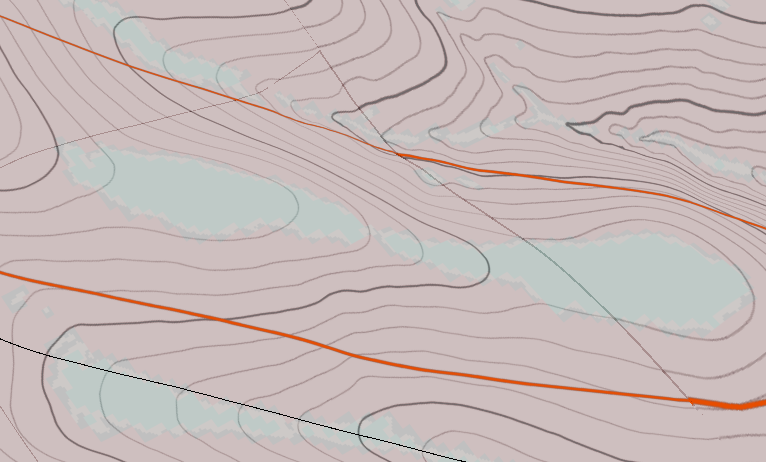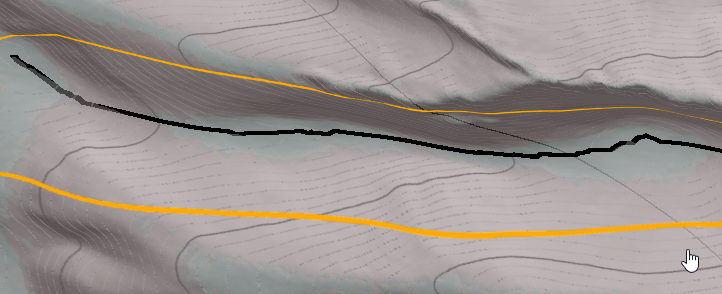- Home
- :
- All Communities
- :
- Products
- :
- ArcGIS Spatial Analyst
- :
- ArcGIS Spatial Analyst Questions
- :
- Re: create polyline(s) or polygon(s) represents 10...
- Subscribe to RSS Feed
- Mark Topic as New
- Mark Topic as Read
- Float this Topic for Current User
- Bookmark
- Subscribe
- Mute
- Printer Friendly Page
create polyline(s) or polygon(s) represents 100 ft vertical setback from ridgelines
- Mark as New
- Bookmark
- Subscribe
- Mute
- Subscribe to RSS Feed
- Permalink
I am posting this question to the SA Community after I have been working on this on and off. I have yet find a consistent solution and hope someone would share insights to the tools I should look into or methodology that's similar to this case.
The problem - To draw polylines or polygons that represent 100ft vertical setback from the ridges (see 2nd screenshot). My study of area is approx 1500 acres. Here is a screen shot.

This is what I have done thus far after soliciting help from the 3D forum and nearby GIS expert. Thus far, all is running on ArcGIS Pro with both SA and 3D available.
Attempted Method 1:
Semi-manually created 3D ridgelines (as shown in black in the screen shot above, and this is not an issue here, let's ignore why the lines have to be manually edited). In Scene, make 2 copies of a ridgelines and duplicate them 100ft vertically down from the original location. The duplicate lines were placed on either side of the ridge while viewing in 3D. Convert the lines to 3D points (Feature Vertices to Point). Then create contour polyline from the 3D points (Add Geometry Attribute then Points to Line). Build a Terrain Dataset, and use Surface Difference tool to create a polygon. The contour polyline was set to hardline. I played with this method twice at the same location with variance in width (meaning how far apart I placed the duplicated lines) but I yield different result depending on how far of the offset lines I placed.
Attempted Method 2:
Based on Abdullah Anter suggestion from my previous posting. It worked for a small area, but cannot apply to a large area. Because my subtracted ridgeline elevation ranges from 400ft to 1000ft at almost every 10ft interval, using the Contour List essentially create new set of contour of the entire terrain. I could however, convert the new contours to a new raster then intersect the my original and new rasters, but what would be the right tool to create the intersecting lines or areas? Cut/Fill?
BTW, I believe this problem can only be done ridgeline by ridgeline, but I welcome any inputs that can shown me otherwise. Any suggestion on how to create a horizontal warped plane from the ridgeline is welcome, too.
Here is snapshot what the Planners would like to see, a band that traverse along the hillside. Thank you.

Solved! Go to Solution.
Accepted Solutions
- Mark as New
- Bookmark
- Subscribe
- Mute
- Subscribe to RSS Feed
- Permalink
Thanks to everyone who replied to my question. I also wanted to thank Hayward's GIS coordinator, ESRI's Spatial and 3D analyst software engineers for guiding me.
Posting my how to doc for anyone who may encounter similar question. Once the procedure is established, processing and data organization time may take the bulk of the time. Ran this on ArcGIS Pro with 3D and Spatial analyst extensions
- Mark as New
- Bookmark
- Subscribe
- Mute
- Subscribe to RSS Feed
- Permalink
I have another potential solution to throw out there, but would need someone who is really good at 3D/Spatial Analyst to flesh out the specific tools. Here's the general workflow:
1. Invert your DEM.
How To: Invert a surface using ArcGIS Spatial Analyst
2. Use the Hydrology Tools to derive the streams (this will take take several process steps). This will essentially derive your ridgelines.
Deriving runoff characteristics—Help | ArcGIS for Desktop
An overview of the Hydrology toolset—Help | ArcGIS for Desktop
3. Once you have the streams, flood the area 100 feet.
(I'm not sure how to do this part)
4. Invert the data back.
Let me add some folks who I suspect know some or all of how to do this:
EDIT - added more information / clarified sentences
Chris Donohue, GISP
- Mark as New
- Bookmark
- Subscribe
- Mute
- Subscribe to RSS Feed
- Permalink
Chris - Thanks for helping again. I should've posted this earlier. I follow these steps to create the ridgelines, but the outcome gets to too granular hence I have to go in and do manual editing.
- Mark as New
- Bookmark
- Subscribe
- Mute
- Subscribe to RSS Feed
- Permalink
by too granular, do you mean that the lines were a bit disconnected? If so you can 'Expand' your ridgelines to make them a bit bigger and hopefully connect prior to converting to polylines. There was a recent thread on this disconnected nature, but I can't put my hand on it right now.
- Mark as New
- Bookmark
- Subscribe
- Mute
- Subscribe to RSS Feed
- Permalink
Dan - Thank you. There were many parallel ridgelines. With that said, I can take care of them rather quickly with manual connecting and editing. I need more inputs and guidances on how to chop off the ridges based on the subtracted elevation.
- Mark as New
- Bookmark
- Subscribe
- Mute
- Subscribe to RSS Feed
- Permalink
I relooked at the image, the Planners desire only parallels the ridgelines in the eastern most reach, don't know how you would handle the western section
- Mark as New
- Bookmark
- Subscribe
- Mute
- Subscribe to RSS Feed
- Permalink
Dan - I owe you a clarification. The Figure 1 below is the same area as what's shown on this post above. Figure 1 is a 2D/Ortho view. The black line (not show earlier) is the derived ridgeline. The orange lines are approximation of where the horizontal warped plane would intersect with the ridge 100ft vertically below the ridgeline. The orange line is just a representation that may be incorrect. I merely want to show what the Planners desire to see on paper. From 3D perspective, figure 2, the orange line conform to the hillside terrain. Sorry to keep on repeating, but orange line is what I need for representation but may not be correct in the figures shown below. Does that make sense?

Figure 1 2D - orthoview

Figure 2 3D
- Mark as New
- Bookmark
- Subscribe
- Mute
- Subscribe to RSS Feed
- Permalink
Thanks to everyone who replied to my question. I also wanted to thank Hayward's GIS coordinator, ESRI's Spatial and 3D analyst software engineers for guiding me.
Posting my how to doc for anyone who may encounter similar question. Once the procedure is established, processing and data organization time may take the bulk of the time. Ran this on ArcGIS Pro with 3D and Spatial analyst extensions